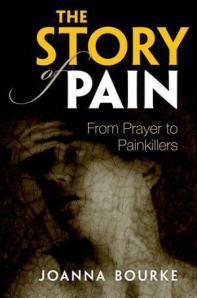Vince Darcangelo's Blog, page 10
August 16, 2014
A Darker Shade of Summer (Nonfiction)
A round-up of true-life horrors to darken you summer.
The Story of Pain: From Prayer to Painkillers
(June 26)
In what is surely one of the most interesting books of the summer, Joanna Bourke, a history professor at Birkbeck, University of London and a Fellow of the British Academy, explores the history of pain—how we describe it, how we think about it, and how we deal with it.
Bourke writes that we’ve spent far more time documenting pain alleviation rather than exploring pain itself, and her detailed survey, focusing on the past three centuries, will surprise and inform all readers.
One would think that pain hasn’t changed much over time—pain is pain, after all—but while migraine accounts have remained similar, our relationship to suffering, and sufferers, has changed in dramatic ways. Once thought of as a supernatural punishment or an opportunity for personal growth, pain is now considered an external evil, an inconvenience, something to be eradicated rather than embraced.
Most striking, for me, is the chapter on estrangement. Pain isolates the afflicted, but remarkably, it’s the person in pain who does the distancing. Be it the stigma of sickness, the desire to insulate loved one’s from their suffering, or simply not to be thought of as a whiner, the sufferer tends to keep their agony to themselves.
And as anyone in the throes of a migraine can attest, communication isn’t a vacation. Bourke writes: “As well as isolating people-in-pain from their families and friends, physical discomfort works against human exchange by blunting the higher senses and intellect” (46).
Paradoxically, pain narratives also create and strengthen communities, such as support groups that arise around particular afflictions.
Bourke is no stranger to uncomfortable topics. Her other works include Fear: A Cultural History; Rape: Sex, Violence, History and Dismembering the Male: Men’s Bodies, Britain and the Great War.
Utilizing a variety of sources—old medical books, doctor’s notes, poetry, anecdotes, letters and others—Bourke compiles a well-rounded account of suffering, accessible to academics and casual readers alike.
Reading The Story of Pain is a bit like enjoying a sad song on a sunny day. This intellectual read might not alleviate that next migraine any better than “Every Rose Has Its Thorn” can dampen the sting of heartbreak, but it’s interesting to contemplate from an academic distance.
Chinese Comfort Women
Peipei Qiu
with Su Zhiliang and Chen Lifei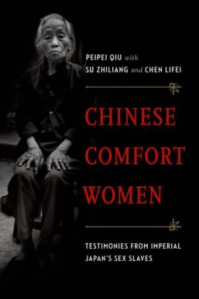
(June 2)
Being obsessed with all things Japanese, it’s difficult to imagine the atrocities committed by Imperial Japan. But the horrors of Dai Nippon Teikoku (which officially ended in 1947, two years after Japan surrendered to the Allies at the end of World War II) still resonate for the victims.
Among them are the “comfort women”—young girls from occupied countries, such as China and Korea, who were forced and coerced into prostitution, enslaved at military brothels.
In Chinese Comfort Women, Peipei Qiu, along with two China-based scholars, provides the oral history of a dozen survivors. It’s a dark, important narrative, an old wound that still stings, a reminder of the darkest hour of the 20th century.
In another generation, there will be no more survivors of WWII, and Qiu, Zhiliang and Lifei have done a great service by recording the personal narratives of these women while they’re still with us.
Coming Soon
Modern Conspiracies: The Importance of Being Paranoid

Emma A. Jane and Chris Fleming
(Release date: Aug. 28)
Here is a book certain to lend credence to the quip: Just because I’m paranoid, that doesn’t mean they’re not out to get me. This academic book, authored by two Australian professors, reconsiders conspiracies—and their theorists—not as part of the lunatic fringe, but as a window to our relationship with the truth.


August 14, 2014
A Darker Shade of Summer (Fiction)
A round-up of ghost stories, thrillers and dystopian anthologies to darken you summer. (Come back tomorrow for our nonfiction edition.)
Ten Short Tales About Ghosts
(Released June 28)
Typically, the hallmark of a great ghost story is that it unsettles the reader. When reading K.C. Parton’s collection of English ghost stories, however, one is filled not with dread, but comfort. These 10 tales are reminiscent of the kind my father would tell me over campfires—and those, of course, will always be my favorites.
Parton’s stories have that same appeal. These are not tales of terror, but subtle chillers made all the more spooky for their familiarity. Stories that make you think twice before cutting through the graveyard, not to avoid falling prey to a Saw-like killer, but for that abstract fear that tickles as much as it terrifies.
In “The Last Train,” a modest theater-goer arrives late to the station, but by good fortune, his train is waiting for him. Once aboard, he realizes his destination is somewhere other than home. Likewise, a young factory apprentice stumbles upon a shop-floor oddity in “The Cleaner”—and realizes that what he first thought to be a hoax or a hazing is in fact a haunting.
Perhaps the stand-out tale of this collection is “The Heinkel,” a WWII yarn about a young boy fascinated with a downed German plane.
A big draw for me is that most of the stories have an industrial setting. Growing up in the Rust Belt, I was exposed to the real-life horror of the steel mills (such as my dad’s coworker losing an arm in the blast furnace) and the spooky kind (my grandfather’s otherworldly encounters at the Westinghouse plant).
When it was my turn to work the factories, I found much ghostly inspiration in the rusted machinery, secluded warehouses and the imaginative possibilities of the graveyard shift. Parton’s stories fit that mold, which shouldn’t be surprising, as he came of age in England’s post-war factories. (His first book, Tales from the Toolbox, recounts his industrial experiences.)
My one critique is that there’s not a lot of mystery to these stories. Characters who believe they are having ghostly encounters truly are, and the nature and cause of the hauntings are typically self-evident. But that’s OK. These stories work not through terror or misdirection, but by tapping into that primal need for campfire tales—the kind that give goosebumps, sure, but leave you smiling in the end.
Ominous Realities
Eds. Anthony Rivera and Sharon Lawson
Once again, Grey Matter Press has delivered the anthology goods. Ominous Realities is the finest indie collection I’ve read in a while. These dystopian tales chill and unsettle, balancing skill, imagination and smarts.
Take “On the Threshold,” an eerie, Lovecraftian tale of science and madness from William Meikle. Last year, I read Meikle’s novel The Hole, and thought it was enjoyable but flawed. Here, Meikle is in control from the creepy opener in the lab to the grim finale. HPL would love this tale of science gone wrong.
Keeping up the intensity is “Doyoshota,” by Ken Altabef, a haunting intersection of conspiracy and cacophony that makes tinnitus sound like a Beethoven sonata.
Eric Del Carlo’s “We Are Hale, We Are Whole” is deserving of any “best-of” anthology, a smart, thoughtful piece of writing that should be a must-read for anyone attempting to world-build within the confines of a short story. It also takes a philosophical bent about quality of life, aging, health care and sacrifice.
An excellent collection from a hot new publisher. Also be sure to check out their Dark Visions II anthology.
Coming Soon
Mean Streak
Sandra Brown

(Release date: Aug. 19)
Mean Streak has all the makings of a classic Sandra Brown thriller: abduction, deception, moral complexity and a revelatory rabbit-hole twist. In her new novel, Dr. Emory Charbonneau disappears, and her husband is the primary suspect. Part crime novel, Mean Streak is also a survival narrative, as Emory awakes in the hands of a violent captor who may be hiding his true identity. I haven’t read this yet, but it sounds reminiscent of Standoff, which was one of her best works.
The Black Road
Tania Carver
(Release date: Aug. 15)
While the plot may be a little, well, plausibility challenged, advance press offers Mo Hayder levels of gore and depravity (aka horrific awesomeness). Following a mysterious explosion, criminologist Marina Esposito’s husband is in a coma and her young daughter is missing. The abductor forces Marina to complete a series of depraved tasks in the course of three days or her daughter dies. So, yeah, it may be plot-challenged, but if you’re looking to spice up your summer with some gore, The Black Road just may be a detour worth taking.


July 13, 2014
Review: Happy Clouds, Happy Trees: The Bob Ross Phenomenon
One of my favorite songs has a line that goes, “Tell the kids to keep on coloring outside the lines/ Until they lose their limitations and their minds are free/… And tell Bob Ross thanks for all the happy little trees.”
The song is “To Bob Ross, with Love,” by Gym Class Heroes, and they crush it on more levels than I have blog space to discuss. So I’ll give you the bullet points.
It’s a great song, regardless of the theme
It’s a song that encourages creativity, imagination and pursuing your dreams
I’m a sucker for songs like that
I love Bob Ross and always watched his show growing up (and still do whenever I can)
I hope to one day have a pocket squirrel, like Pea Pod, who helps me paint
I totally dig those ASMR channels on YouTube (which I trace back to Bob Ross)
I’m one of those kids who was encouraged to color outside the lines
I didn’t have coloring books growing up. I had blank sketch pads. My parents didn’t want to impose on me the pressure of conformity and a color-by-numbers world. When I wanted to create, I was given a blank sheet. It’s served me well.
To use another quote from “To Bob Ross, with Love”: “My mama made me this way/ I thank her every day.”
Preach it.
So I admit there was trepidation when I started reading Happy Clouds, Happy Trees: The Bob Ross Phenomenon. It’s an academic book, from the University Press of Mississippi, penned by Kristin G. Congdon and Doug Blandy, and illustrated by Danny Coeyman. I feared that an academic treatment would reduce those joyful half-hours of public television bliss to a post-structuralist treatise. Thankfully, that is not the case.
The focus of Happy Clouds, Happy Trees is the phenomenon of the painter and the cult-like nature of his fans, which is incredibly fascinating.
Ross is all the more mysterious for the minimal amount of unauthorized or paratextual materials surrounding him. Mostly, what we know of Bob Ross comes from his program. We don’t have a cache of letters, no scandalous videotapes and, most significantly, no family interests looking to exploit the painter, who died in 1995, for a fast buck.
That’s good and bad. The good is that those of us who grew up watching Ross still know him only by his on-screen persona, not his off-camera flaws. By comparison, the premieres of The Joy of Painting and Michael Jackson’s Thriller came a mere 42 days apart.
It’s still possible to watch The Joy of Painting without feeling dirty.
The mystique of the painter’s life has fueled his cultish (in the best sense of that word) following, and the authors do a wonderful job of exploring the Bob Ross phenomenon and its devotees.
One of the most fascinating narratives in the book is the trinity of Ross, Andy Warhol and Thomas Kinkade. While Ross and Kinkade are sometimes paired in the collective consciousness (due to their being the only two contemporary painters many Americans know by name), they could not be more different. While Ross did his show for free (his income came from art instruction and supplies), Kinkade never met a check he didn’t cash. Ross idealized the wild outdoors, while Kinkade idealized property and domestication. Ross never sold his artwork, while Kinkade established a corporation, chain stores and a subdivision modeled after his paintings.
Perhaps the most significant difference is that Kinkade automated the process, mass producing prints with a few dabs of paint (done by other artists and, occasionally, Kinkade himself). Ross was all about the process. It wasn’t The Profits of Painting, it was The Joy of Painting. We don’t collect Ross, we connect with Ross. The focus is the act of creation, not its end product.
The authors argue, rather convincingly, that we should instead be comparing Ross with Warhol. The two make an odd couple at first, but by book’s end, the connection is apparent. Both defied the norms of fine art and gallery culture (though they were received very differently by that world), and both had a working-class ethic to their craft.
I doubt that MoMA will be racing to organize a Ross retrospective anytime soon, despite the well-composed arguments of Happy Clouds, Happy Trees.
Ultimately, as the authors write, it doesn’t matter. The Bob Ross Phenomenon has nothing to do with fickle gallery predilections or snooty art criticism.
It’s all about the man, our connection to him and that ineffable thrill of creation. Bob had a word for it.
He called it joy.


June 27, 2014
Review: Justice, Inc.
In the introduction to his short story collection, Justice, Inc., Dale Bridges prepares us for the satirical rapture he is about to unleash: God, discouraged by his failed attempts to kill off the human race, comes to the realization that “…when left to their own devices, they appeared to do a fair job of exterminating themselves.”
off the human race, comes to the realization that “…when left to their own devices, they appeared to do a fair job of exterminating themselves.”
And thus the chain catches on the death-coaster, drags it to the summit and lets that fucker drop.
Hang on.
These are masterful tales of human obsolescence, cruel absurdities and species self-deliverance. Albert Camus wrote: “Man is mortal. That may be; but let us die resisting; and if our lot is complete annihilation, let us not behave in such a way that it seems justice!”
He would love this book.
In Bridges’ world, justice is self-imposed, whether or not his characters realize it. You want the convenience and savings of a Wal-Mart? Fine, but you have no one else to blame when you wake up in a world controlled by Wal-Marts. Punishment fits the crime.
This is the type of justice that runs through this collection. The settings are typically dystopian and of our own making. It is human nature to barricade the doors or erect walls to repel that which threatens us, only to realize that we have constructed our own prison cell.
Just ask Poe’s Prospero, whose harlequin fortress was child’s play for the Red Death.
Justice, Inc., published by the formidable Monkey Puzzle Press, manages to be both observational and engaging, philosophical yet lyrical at the same time. You’ll find yourself caring as much for the characters and their plights as for the underlying philosophy within each tale.
The opening story, “Welcome to Omni-Mart,” is reminiscent of Kurt Vonnegut’s “Deer in the Works” updated for the big-box generation. Leonard was adopted by Omni-Mart as a child and now, at forty-two, lives, works and philosophizes within its walls, deathly afraid of The Outside.
It’s a synthetic, corporate dystopia that is, sadly, all too familiar.
“Life After Men” is a sardonic take on dysfunctional relationships and how we, inevitably, are drawn to, and driven by, the things that destroy us. Oh, and did I mention this plays out against the backdrop of some wild, gender-specific apocalypse?
This segues into the darkly comic (and karmic) “The Girlfriend™” in which the protagonist, Derrick, blurs the line between physical and factitious love. For Bridges, the femme fatale has been replaced by the sentient sex robot. (Of all the dystopias in all the dystopian universe, she had to walk into mine.)
Bridges writes not with a pen but a skewer, piercing the absurdity of our cosmic sitcom with clarity and humor. Justice, Inc. is philosophical satire in the vein of Vonnegut and George Saunders—fellow madmen who have stared into the abyss and come away laughing.
Obligatory disclaimer: Bridges is a friend and former coworker. We worked (and suffered) together at the Boulder Weekly newspaper, where he succeeded me as arts and entertainment editor. We also worked together on Transgress magazine, where three of these stories originally appeared.
I can attest to the quality of the man, his writing and his conviction.
I can also warn you, from first-hand knowledge, that Bridges may very well be the madman Nietzsche wrote about—and the bringer of the end times.
Be warned that there is a fifth steed of the apocalypse, and its name is Justice—and Bridges is lashing the whip, breathing fire and coming for us all.


June 21, 2014
A Trinity of Science and Spirituality
Faith and Wisdom in Science
Tom McLeish
As much as I love a good intellectual debate, when it comes down to it, I’m a sucker for a good reconciliation 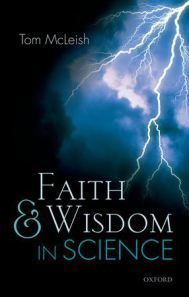 thesis—a text that searches for common ground, or at least common interests. It’s why I loved Jonathan Haidt’s The Righteous Mind, and why, despite my passions, I do my best to avoid polemics, with varying degrees of success (I think Christopher Hitchens should be required reading, while I didn’t care for Richard Dawkins’ The God Delusion, though I agree with his premise).
thesis—a text that searches for common ground, or at least common interests. It’s why I loved Jonathan Haidt’s The Righteous Mind, and why, despite my passions, I do my best to avoid polemics, with varying degrees of success (I think Christopher Hitchens should be required reading, while I didn’t care for Richard Dawkins’ The God Delusion, though I agree with his premise).
Reading only what supports your beliefs leads to entrenchment and intellectual idleness. Equally lazy is cherry-picking only the extreme views on the opposite side, as it offers a skewed perspective that is easily caricaturized and dismissed (e.g. thinking the Westboro Baptist Church is representative of all Christians or that Ann Coulter is speaking on behalf of human beings).
So it was with great interest that I cracked open (does that expression apply to e-books?) Faith and Wisdom in Science by Tom McLeish, a physics professor at Durham University.
I liken it in tone and intention to Buddhist Biology, by David Barash, a brilliant book in which the author explicates his self-proclaimed Buddhist atheism. However, while Barash delivers a very personal narrative, McLeish takes a more historical focus.
McLeish is a talented writer, which makes Faith an easy and enjoyable read. He explores the history of both scientific discovery and biblical narrative, finding commonalities in the ways humans in each arena are awestruck and inspired by the natural world. Here, he points out parallels, but I don’t think he presents a strong argument. Yes, people from biblical days share our fascination with reality, and myth-making was our earliest stab at explaining the world.
That doesn’t mean that biblical passages are relevant to modern science.
I do appreciate his discussion of the individual’s experience with the natural world. There is room, he argues, for the sublime in science. “By actually working through some real science ourselves, so that we are reminded what it ‘feels like’, we have found it to run rather deeper and to touch more nerves…”
Which segues to McLeish’s strongest topic: The unfortunate divide between the sciences and the humanities. The earliest scientific studies were not the cold, heavily controlled research we have today, he writes, but passionate probes of the natural world. There has since developed a rift between the science and humanities. Science got custody of the brain in the divorce, and humanities, the heart.
Somewhat tangential, though I think relevant, is an article in the Summer 2014 issue of Philosophy Now, “Are There ‘Other’ Ways of Knowing?” The author, philosophical science correspondent Massimo Pigliucci, revisits a conversation on science and philosophy he had with heavyweights Dan Dennett and Lawrence Krauss.
The takeaway is that science, he writes, is too quick to dismiss non-scientific, or non-empirical, knowledge, such as mathematical knowledge, phenomenological experience and intuition (as in subconscious processing, not precognition).
I found it a helpful companion to McLeish’s book, as it shows how easy it is to become dogmatic in the sciences.
But to finish with McLeish, I will draw one final comparison: Cosmos. Both the original and the reboot are classics because they impart knowledge without diminishing the wonder of the natural world. In fact, I would argue that the more we learn of the natural world, the more wondrous it appears.
And like Neil deGrasse Tyson, McLeish is affable, informative and, in my opinion, has written a book not so much about science and religion, but rather on that greatest of virtues that we should never lose, but often do: childlike wonder.
If you still feel the sublimity of mountain peaks, marvel at existence at the subatomic level or can be moved to tears by a sunrise, you’ll enjoy Faith and Wisdom in Science.
Why Be Catholic?
Patrick Madrid
I would love to grab a beer with Patrick Madrid. Beginning by analogizing the Catholic Church with Noah’s Ark—and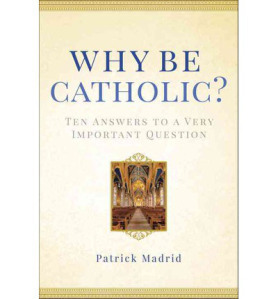 not always in a flattering manner—he comes across as funny and self-effacing, and very likeable.
not always in a flattering manner—he comes across as funny and self-effacing, and very likeable.
It’s easy to see why Madrid is a popular blogger, lecturer and apologist. It’s this accessibility that will draw readers to Why Be Catholic?: Ten Answers to a Very Important Question, a short work with a lot of personality—but little to offer in terms of intellectual debate.
Going into this book, I had hoped it was intended for a general audience. Unfortunately, it is directed toward the choir. As I’m not part of the choir, I had hoped there would be a substantive argument drawing on scholarship and exegesis, but Madrid’s answers appear to have been composed to reinforce the faithful and educate believers of other denominations on the customs of the Catholic Church.
It is not an argument for Catholicism for nonbelievers, but rather for non-Catholics.
Madrid makes reference to atheists, agnostics and others, but never directly addresses these groups. Case in point: He mistakenly writes of the “miracle” of Lanciano that “Scientists have not been able to explain it, nor have atheists been able to debunk it.” Well, the burden of proof is on the believers, not the scientists. The church is in possession of a bit of human tissue and blood, allegedly consecrated from bread and wine ~700 C.E. No dispute there. They have human tissue and blood. So does Dexter. What proof exists that they started as tapas?
But to be fair, that’s not the point of Why Be Catholic?. This book is for readers for whom issues of existence or nonexistence have already been decided. If you count yourself among them, then I recommend this book as a light, enjoyable read.
For theological debate, try elsewhere.
My preference would be to discuss it with Madrid over a beer. Or maybe tapas.
Blood: A Critique of Christianity
Gil Anidjar
I’m not sure where to begin with Blood, except to say that it may well be defining its own genre. It’s challenging, 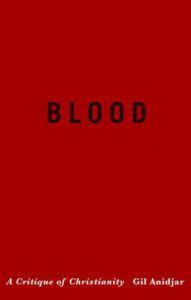 controversial, lyrical, overly referential, meandering, meta-everything and modest.
controversial, lyrical, overly referential, meandering, meta-everything and modest.
OK, I lied about the last one. This book is quite full of itself.
But don’t take that as a bad thing. It’s a book that demands its own terms, and I respect any author willing to challenge their reader. Anidjar does present a challenge. The fault, though, is that he doesn’t appear to address it to the reader.
Reading this felt like missing the first day of class and coming to the second with no review. There is a conversation happening that I don’t seem to be a part of. Perhaps that’s because I’m a lay reader. Academics and the many readers smarter than me may have better luck, but I struggled with this one.
While that’s partly on me, there is also a lack of clarity in Anidjar’s writing. He has a penchant for winding sentences, extended parentheticals and pivots of thought that left me in the weeds. He strikes me as a brilliant thinker, but struggles with communicating those ideas.
Again, this is partly on me and partly on him.
This is a worthy challenge for any reader.


May 17, 2014
Review: Insatiable
Insatiable
Asa Akira
I had high hopes for Asa Akira’s memoir. I imagine being a porn star makes for an  interesting life, and I was hoping to learn about the person, not the persona (which is already widely available on the Internet).
interesting life, and I was hoping to learn about the person, not the persona (which is already widely available on the Internet).
Unfortunately, Akira wrote the book in character.
Consider the sex scenes. Of course sex is going to come up in a porn memoir, but I wasn’t expecting it in the form of Penthouse Letters-style prose. My take is that it’s a distraction. By focusing our gaze on the sex, Akira deflects the attention away from herself.
What I wanted from Insatiable was the side of Akira we haven’t seen yet, and she noticeably shies away from the interior reflection required of memoir. Perhaps this is a survival skill inherent among those in the sex industry: It’s easier to open up physically than emotionally.
Fair enough, I suppose.
What I can’t excuse, however, is the tone. In the adult industry, female characters are typically portrayed as hyper-sexualized, submissive and eager to please. (Think Marilyn Monroe singing “Happy Birthday” to JFK or the nature of small talk made around stripper poles.) It’s understood that these are on-screen characters, but when the actor extends this behavior beyond the camera lens, it is inauthentic at best and caricature at worst.
Akira does show her depth at times, such as while discussing the growing intersection of porn and prostitution. This is the kind of dialogue I was looking for, but even here, I don’t believe she truly mines her interior. What could have been an important conversation is ultimately reduced to an anecdote, though an interesting one to be sure.
I’m reminded of the album cover of KISS Unmasked. It is paneled in the form of a comic book in which the musicians remove their “masks” at the end. They reveal that underneath their face paint they look exactly the same. It’s a clever gag, but it’s meant to obfuscate, not uncover.
I feel the same way about Insatiable.
It’s clever and shows a lot of promise. Akira’s narrative is fast-paced, the content readable and at times laugh-out-loud funny. If you’re a fan of Asa Akira, this is an enjoyable, though not essential, read.


May 14, 2014
Review: The Tale of the Dueling Neurosurgeons
The Tale of the Dueling Neurosurgeons
Sam Kean
The fact that Sam Kean has yet to win a major publishing prize is an oversight that must 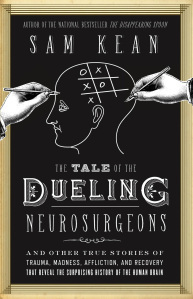 be righted this year. Kean’s previous books, The Disappearing Spoon (2010) and The Violinist’s Thumb (2012), were critically acclaimed best-sellers, but garnered no love from the folks at the Pulitzer and National Book Award.
be righted this year. Kean’s previous books, The Disappearing Spoon (2010) and The Violinist’s Thumb (2012), were critically acclaimed best-sellers, but garnered no love from the folks at the Pulitzer and National Book Award.
Spoon was nominated by the Royal Society as one of the top science books of 2010, and Thumb was a finalist in the PEN literary science writing category, but the former is based in London and the latter prize went to another author.
The Tale of the Dueling Neurosurgeons: The History of the Human Brain as Revealed by True Stories of Trauma, Madness, and Recovery provides the prize judges with a chance to make it right.
As with his other books, The Tale of the Dueling Neurosurgeons is a brisk and engrossing read. Kean’s appeal is his ability (like that of Mary Roach) to equally entertain and educate. He keeps you so absorbed in the narrative that you’re unaware how much you’ve learned until you hear yourself dropping scientific factoids at a dinner party.
With Kean, scientific advancement is never dull. He has a nose for the quirky, the quacky and the querulous.
However, his new book may be his most impressive yet, on a personal level. Part of what made Spoon and Thumb so interesting to me was the thrill of discovery. I knew little of chemistry and DNA before cracking them open.
Therefore, the true test of his writing prowess would be The Tale of the Dueling Neurosurgeons, a subject a bit closer to my wheelhouse. I never scored high in chemistry or biology, but I graduated with honors with a degree in psychology.
How interesting could he make this familiar subject?
Kean dug deep into the archives of psychology to discover little-known and sometimes forgotten gems that have had a great impact on modern science, and he infused newfound wonder into time-worn stories, such as Phineas Gage. You will laugh. You will learn. At times you will pick your jaw off the floor and ask yourself, “That happened?”
If you’ve never read Sam Kean, start now. You will devour all three books in a week. If you’re a longtime fan, prepare to be wowed once again.
And if you’re a judge for any of the big literary prizes, in the name of all that is just and good, start etching Sam’s name into the trophy.


April 17, 2014
Review: Beasts
Beasts: What Animals Can Teach Us About the Origins of Good and Evil
Jeffrey Moussaieff Masson
I’ve long struggled with the language people use when discussing animals. The idea of 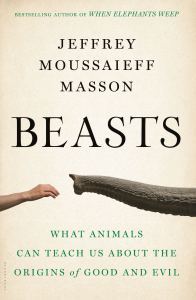 getting your cat or dog “fixed,” for example, is simply moronic. There’s nothing broken with our animals’ reproductive systems. The problem is that they’re working too good!
getting your cat or dog “fixed,” for example, is simply moronic. There’s nothing broken with our animals’ reproductive systems. The problem is that they’re working too good!
That’s like removing the battery from a working clock and saying you’ve fixed it.
It’s not that controlling the reproductive habits of our companion animals is a bad idea. Of course I’m a proponent of spaying and neutering—particularly TNR outreach programs that are doing amazing work throughout the world.
But as a writer I’m also a supporter of the rhyme and reason—the simple logic, if you will—of language. I can accept the phrase “put to sleep” as a euphemism for mercy killing, but “fixed”?
A similar misnomer—and one deserving of far more vehemence—concerns the use of animal language to describe acts of human cruelty. Killers and rapists are commonly referred to as “beasts,” “brutes” or, in the parlance of Hollywood noir, “you filthy animal.”
True, the animal kingdom is a violent world, but even the worst behavior is driven by the need to sate appetites, not for the sake of sadism. At an animal shelter where I worked, we once took in more than two dozen Australian shepherds from a puppy mill in Nebraska. Most of the puppies could be rescued. We were able to socialize, rehabilitate and adopt them out to loving homes.
A handful of others were too sick, malnourished or traumatized to recover and didn’t respond to medical treatment or therapy. They were euthanized, and it was an act of kindness.
There were a few others dogs, however, who had been abused to the point of aggression—dogs with such an inbred fear of people that they couldn’t improve under the best behavior mod training we had to offer.
There was one dog in particular who broke my heart. His life was a perpetual state of fight, flight or freeze—he was unable to flee and freezing wasn’t in his nature. He filled with terrified rage anytime someone approached his kennel, even for feedings. He would fling his body from wall to wall and bash his head against the cage—climbing, jumping, snarling.
When it came time to euthanize him, it took four of us, a net and two vials of tranquilizer to get him sedated. The desperate, implacable fear in his eyes was disarming, and it still troubles me to think of the living conditions and daily abuse that had terrified him so. I hope I never again have to see a creature that afraid.
As we carried his unconscious body to the kill room, I wished that we were injecting toxins into the fucker who ran the puppy mill rather than the dog. It pained me to destroy that animal, but I would have had no guilt or second thoughts of putting that guy to sleep.
Like Dexter, I wanted him plastic-wrapped on my table.
I wiped my eyes after the dog died, and it’s not hyperbole when I say I wouldn’t have shed a single tear if I’d delivered the needle to the mill owner who did this to these dogs.
That’s why I find it odd that when someone commits a heinous act, it is referred to as “animalistic” or “inhumane.” I’ve never known a dog that would abuse people the way puppy mill workers mistreat and exploit animals for profit. Unlike the FBI, animal control doesn’t need a profiler to understand the brutality of its species.
And dog fighting? As far as I can tell, we humans are alone in training and forcing other species to fight to the death for our entertainment.
No, I would say the likes of Michael Vick aren’t “animals,” “beasts” or less than human. To borrow from Nietzsche, I would say they are human, all too human.
Which brings me to Beasts: What Animals Can Teach Us About the Origins of Good and Evil, by Jeffrey Moussaieff Masson, a somewhat academic, somewhat philosophical and all-around interesting book about animals and morality.
Like his previous books, such as Dogs Never Lie About Love and When Elephants Weep, Masson studies the emotional behavior of animals (such as love, grief and contentment) and searches for lessons that can be applied to humans. In Beasts, he is looking at anger and aggression.
The centerpiece of his argument is concise as it is uncomfortable: Humans and orcas have the most complex brains in history, yet of these two, only humans kill members of their own species.
A poignant fact—and an excellent point of entry for a discussion on human behavior. Masson gives us much to think about as he lays out his argument; however, he oversteps from argument to advocacy in places, building off conclusions that seem far from settled.
I’m in agreement with Masson that humans are capable of and culpable for the greatest violence against our own species in the animal kingdom. We even get bonus marks for creativity. Predator drones, IEDs, beheadings, shoe bombs. Who would think to torture and kill other sentient beings in the absurdly original manner that we do?
However, Masson paints a pastoral of nature without humans, and this idyllic view makes it difficult to buy into the author’s argument. I’m reminded of the episode of Family Guy in which Death goes on a date with Amy, the Pollyannaish pet-shop girl whose Disney-fied view of nature causes Death to “terminate” their relationship.
Masson has a complex and sophisticated view of nature, but his conclusions appear to be based more on opinion than evidence. Still, it’s a compelling commentary, and I would recommend it for anyone interested in animals and nature.
I agree that we could learn much about social behavior from animals, but I would take Masson’s conclusions as part of an ongoing discussion and an invitation to further research.
And for further reading, I would also suggest the magnificent and thought-provoking article by James McWilliams, “Loving Animals to Death,” in the current American Scholar.


April 8, 2014
Review: The Mad Sculptor
I first encountered Harold Schechter in the mid-’90s at the (sadly) now-defunct Twice-Loved Books in Youngstown, Ohio. My friend Todd and I would travel there often, lost 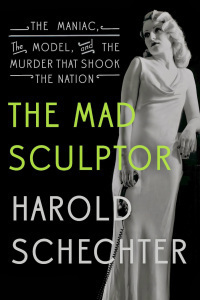 for hours among their three floors of books and playing with the occasional store cat.
for hours among their three floors of books and playing with the occasional store cat.
You would most often find me in the basement, where the true crime section was wedged into a nook behind the stairs. And you would most often find a Schechter book tucked beneath my arm.
I am not only a fan of crime writing, but an advocate. There is a stigma with the genre that I have always felt was undeserved. Even in progressive-minded bookstores like Twice-Loved (where I was able to order first-edition Aleister Crowley tomes in the pre-Internet age), crime reporting was given only subterranean shelf space.
That’s a shame. Crime writers like Schechter are historians, sociologists, documentarians and cultural commentators, and to be relegated to back-shelf status by the literary mainstream is a disservice to the many great writers (and well-informed readers) working in the genre.
I asked Schechter about the breadth of his work in a 2012 interview:
“You can certainly learn as much about a society by which crimes people are obsessed with at a particular time,” he said. “I think, in a general way, the crimes that become national obsessions, that strike a deep communal chord, symbolize the particular cultural anxieties of the moment.”
In the 1920s it was poisoners; in the ’70s Charles Manson personified the worst fears of the counterculture; the ’80s had phantom Satanists and the ’90s belonged to the serial killer; and today we have the rampage shooter.
But in the 1930s, it was the sexual deviant that haunted and titillated the public.
Enter Robert George Irwin, the subject of Schechter’s new book, The Mad Sculptor: The Maniac, The Model, and the Murder that Shook the Nation.
Irwin was a troubled and talented artist whose stunted psychosexual development (and religious obsession) fueled romantic fixations, violent outbursts, numerous hospitalizations and an attempted self-castration. It climaxed with a vicious triple murder in 1937, made all the more newsworthy because one of the victims, Veronica Gedeon, was a pulp magazine cover girl.
That in and of itself would make for a good read, but Schechter is a skilled storyteller and, more importantly, a devoted historian. His research into the man who would become The Mad Sculptor not only unearthed a traumatic upbringing, but also documented the changing post-Depression personality of the Beekman Hill neighborhood where the murders occurred.
Turns out this neighborhood was home to a series of sensational murders a year prior to Irwin’s massacre.
Weaving a wealth of historical documents into a cohesive narrative, Schechter gives us not only the crime and the cultural mindset, but also the role the media played in the tale, from the earliest indictment of an innocent man through fictional jailhouse confessions and a business arrangement with the Chicago Herald-Examiner so shady that it would make Rupert Murdoch cry foul.
In fact, all of the media coverage (including the persistent “blame-the-victim” approach that made a fuss over Gedeon’s modeling career and her father’s fondness for “French art” postcards) makes today’s television news seem downright ethical (well, almost) by comparison.
If I have one critique of The Mad Sculptor, it’s that we don’t learn much about Irwin’s time in prison. We get factual data, such as how long he lived after his conviction, when he died, and such, but not the in-depth reporting showcased in previous chapters.
But in a time when most movies and many books run far too long (only quantum physics can explain why it takes longer to watch The Great Gatsby than it does to read the book), it’s not really a bad thing to say that Schechter could’ve gone on for another hundred pages or so and I would have been with him all the way.
Schechter had a run in the 1990s that would make any writer jealous, penning best-sellers about Albert Fish, Ed Gein and Depraved, Schechter’s account of H.H. Holmes.
The latter is an example of the literary caste system writ large. Depraved, published in 1994, predated Erik Larson’s The Devil in the White City by nearly a decade. While both tell the story of the same man—and the same crimes—one is relegated to the dusty shelves of true crime while the other is a modern classic and prominently displayed at the front of the store.
This is not a knock on Larson’s book (he did nothing wrong by writing an excellent book and reaping success), but rather an example of the double-standards that sometimes emerge in publishing. I point this out not to get on a soapbox but rather to appeal to readers who may never otherwise stray to the nether regions of the bookstore or think that crime writing isn’t for them:
Yes, you will find The Mad Sculptor in the true crime section, but it is greater than the sum of its kill count.
Yes, Harold Schechter is America’s finest crime writer, but he is so much more.
Let this book be your introduction to another historical viewpoint, and don’t be afraid to drift to those shadowy corners of the bookstore where you’ve feared to tread before. To quote Nietzsche: “I am a forest, and a night of dark trees; but he who is not afraid of my darkness will find banks full of roses under my cypresses.”
Take it from the weird kid who spent hours in those shadowy basement corridors, collecting the flowers of history in the dark.


March 31, 2014
Review: The Humor Code
The Humor Genome Project
A journalist and a scientist walk into a bar… travel the world, return to the lab and come out with what is likely the best book you’ll read all year
by Vince Darcangelo
In my graduate form and technique class, our instructor, Steven Schwartz, devoted a three-hour class period to humor. I was shocked to learn that there was a dearth of 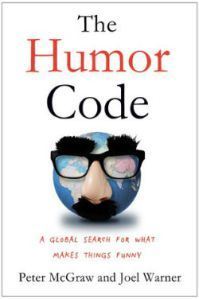 comic literature to study.
comic literature to study.
Why had so few serious writers ventured down that rabbit hole?
“Comedy is not kind,” Schwartz explained to us. “There is blood in comedy, which is why most people shy away from being comic writers.”
Joel Warner and Peter McGraw would agree.
“We’re here to explore the dark side of humor, how comedy can divide and degrade,” they write in their new book, The Humor Code: A Global Search for What Makes Things Funny.
“Here,” in this case, is Denmark, but also Japan, Palestine, Peru and beyond. For more than two years, this odd couple of comedy—Warner a journalist (Westword, Wired, Slate) and McGraw a humor researcher/marketing instructor (at the University of Colorado at Boulder)—traveled the world to learn what incites nasal milk projectiles in other cultures.
Specifically, the intrepid twosome tested whether McGraw’s Benign-Violation Theory (BVT) of humor applied to an international audience.
The theory itself is quite intuitive and elegant in its simplicity: Humor arises from the violation of a norm (be it political, social, personal), but in a way that is recognized as harmless or good-natured (“jk”) by all involved.
The prime illustration is tickling. Taken outside of its traditional context, tickling is a clear violation of personal space, yet it sometimes elicits laughter.
More importantly for the BVT, sometimes it does not.
If a stranger on the bus jabs his fingers in your armpits and begins to wiggle them, the appropriate response is a slap or the tossing of a hot beverage in his face. This is a close encounter of the non-benign kind.
Now, pause for a moment and try to tickle yourself. Go ahead, no judgment. Couldn’t do it, could you? Your fingers go through the motions, but it’s just not the same. That’s because though your intention was benign, it was not a violation of personal space.
Therefore, not funny.
But let your personal tickle monster have at the back of your ear lobes, and you just might cry with laughter. It’s a violation of personal space, but by someone on the guest list—ostensibly with good intentions.
*
So that’s the theory of BVT, how about the application?
For that, Warner and McGraw visit a humor science library in Japan; deliver clown therapy to a Peruvian barrio alongside Patch Adams; interview notorious Danish cartoonists; participate in laughter yoga (yes, that’s a thing); attend comedy festivals; and McGraw even gives stand-up comedy a try in Denver’s toughest room.
That’s a lot to fit into a single book, but you’ll want to read every word. The Humor Code is an engaging blend of science writing, travel writing and narrative nonfiction. This is one of the best books you will read this year, and it is deserving of major awards.
*
Here I’ll pause for a short disclaimer. Let it be noted that Joel Warner is a friend of mine. I have cat-sat for him on occasion, not to mention the numerous times we’ve helped each other stumble home from the Boulder bars at 2 a.m.
For three years, Warner and I were co-workers at an alternative newsweekly in Colorado, and on a daily basis I was witness to his talent, integrity and work ethic. From our earliest days in the newsroom, the editorial team knew he would be writing best-selling books someday.
That day is today.
*
If I had to make comparisons, I would liken The Humor Code to Sam Kean’s The Disappearing Spoon and Eric Weiner’s The Geography of Bliss. Like those two books, the reader comes away knowing more about the topic, and about the world at large, than they would’ve thought when they first cracked the spine—and in a way that makes you laugh as much as you learn.
Mixing the experimental with the anecdotal, here are a few of their discoveries:
“Japan is a high-context society. The country is so homogenous, so unified in its history and culture, that most zingers don’t need set-ups at all.” (“The United States, on the other hand, is as low context as you can get.”)
“…A sense of humor is seen as a sign of intelligence, social desirability and overall genetic fitness. In other words, good jokes are a guy’s version of colorful peacock plumes…”
“We found humor designed to ease people’s pain, a laughter shared by Palestinian street kids and Israeli Holocaust survivors alike.”
The latter observation is the exclamation point to a friendly interaction between a Palestinian shopkeeper and an Israeli policeman. It was a beautiful moment that even had this cynical bastard singing “We Are the World.”
*
But there’s more to humor (and The Humor Code) than just the har-hars and the touchy-feelies. Alongside the camaraderie is the reality of political and cultural blowback. For the tender moments observed in Palestine, there is the reminder that the sketch comedy television show was shut down when it became too controversial. We learn that real life goes on for Patch Adams after his Hollywood ending. There is personal tragedy and, lest we forget, reminders of the embassies and churches that were set on fire, the people who were murdered and those who remain captives in their own homes for fear of their lives because of a newspaper comic.
Yes, because of a newspaper comic.
In a commentary that would do Professor Schwartz proud, Warner and McGraw write:
“We laugh loudest at the most arousing humor attempts, the stuff that’s laced with a bit of danger. So in order to come up with the best comedy, we have to skirt ever closer to the realm of tragedy, hurt and pain. For some people, the result will hit that perfect, hilarious sweet spot. For others, it goes over the line.”
Warner and McGraw aren’t afraid to get their hands dirty, whether they’re mining gallows humor in war zones, dissecting the world’s funniest joke or bombing onstage before a crowd of angry drunks, these guys bravely submerse themselves in the blood sport that is comedy.
They write: “It’s almost as if making people laugh during dark and troubling times is so vital, so crucial, that it outweighs common sense, and maybe even self-preservation.”
Their observations are sharp, insightful and they’re not afraid to explore the breadth of emotions comedy elicits. They’re even bold enough to be funny on five continents.
Their conclusions? Well, you’ll have to read the book for those, but of course, as with all great literature, you’ll soon learn that the joy is in pursuing the question, not necessarily finding a definitive answer.
The journey might take you to some dark places, so be sure to pack a clown nose with your Band-Aids.
And may all your violations be benign.



